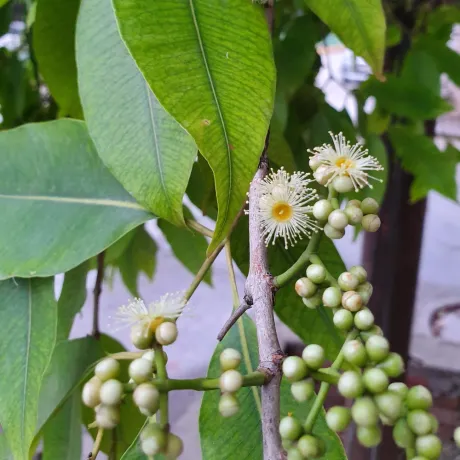Jambu is mentioned among the trees used for the rituals (Kou. Su. 8/15). It is repeatedly quoted by Vedic literature. Asian known as ‘Jambu Dvipa’ is probably named because of its abundance in this area continent. Jambu is considered to be one of the earliest remedies for diabetes. ‘Jambava’ is the name of Jambu fruit. Its bark leaves, fruit, seeds all are used in ancient medicine. Fruit / seed is mainly used in the management of diabetes while bark is used for diarrhoeal disorders. Caraka described it as the best among the substances which aggravates vata (C.S.Su.25).
Different varities–Both Sushruta and Vagbhata (A.H.Su.15/41) have described two varieties of Jambu. Mahendra bhogik and Sodhala mentioned two varieties viz., Raja Jambu and Kaka Jambu. Kaiyadeva, Bhavamishra and Raja Narahari have quoted three varieties viz., Raja Jambu (MahŒ Jambu). Kaka Jambu (Jambu) and Jala Jambu (Kshudra Jambu or Bhumi Jambu). Jala Jambu is otherwise known as Nadi Jambu.
The following may be the botanical sources for the three varieties of Jambu.
- Raja Jambu – Eugenia jambos L. (Syzygium jambos (L.) Alston
(ii) Kœka Jambu- Eugenia jambolana Lam. (Syzygium cumini skeels)
(iii) Jala Jambu – Eugenia heyneana Wall./E. ighantuy Roxb.
Botanical Description – It is a moderate-sized, glabrous tree. Leaves- coriaceous, shining, entire, oval, oval-oblong or lanceolate-oblong, long-acuminate, lateral nerves numerous, parallel, confluent near the margin. Flowers- ighantu, tetramerous, in 3-flowered cymes, arranged in broad trichotomous panicles. Calyx-tube funnel-shaped. Fruit- berry, oblong or subglobose, purple or black, succulent, smooth when ripe.
Major chemical constituents–
Fruits- eugenia triterpenoids A & B, oleanolic acid, malic acid, glucose, fructose, gallic acid etc.
Stem bark & root- Kaempferol, myricetin, quercetin
Leaves- citric, oxalic and ighantu acids; glucose, leucine, sitosterol, dihydromyricetin etc.
Part Used–Fruit, leaf, stem bark
Dosage–Fresh juice 10-20 ml; powder 3-6 g.
Research work–
- Anti-diabetic property– (i) Fresh powdered seed was found to lower the level of blood sugar in diabetic rabbits (Vaish, 1954).
(ii) The fruit and seeds were found to be promising hypoglycaemic agents (Aiman, 1961).
(iii) The aqueous extract of seeds of the plant produced 15-25% fall in fasting blood sugar in four to five hours after giving a single dose orally (Shrotri et al., 1963).
(iv) In non diabetics, fruit pulp induced small but statistically significant fall in blood sugar at 3 hr. whereas in diabetic patients a small increase in blood sugar level was observed following fruit pulp ingestion (J.Res. Ay. & Siddha, 1983,4,1).
(v) In a clinical trial with 80 NIDDM patients, the seed powder (12g/day in three divided doses) was administered for 3 months. The drug produced good symptomatic relief alongwith regulation of blood sugar. It did not show any side effects (Kohli & Singh, 1993).
(vi) Hypoglycaemic activity of E. jambolana leaves is also reported (Arabab et al., 1999).
(vii) In the recent studies the pancreatic regeneration was significantly noticed with seed powder and an American company is reported to file a patent on S. cumini (Eenadu Telugu daily, December, 2002).
(2) Anorexigenic activity of plant extract was approximately equal to that of amphetamine tartrate (Chem. Abstr. 1967, 66, 114288t.)
(3) Dihydromyricetin (0.16 M) inhibited (34.4%) mutation in Salmonella typhimurins as compared to control (Chem. Abstr. 1990,112, 42558 z).
(4) The seed extract is found to be a potential source of male contraception (Sinha et al., 1986).
(5) The stem bark is used in the treatment of diarrhoea and dysentery (Maiti et al., 1985 & Siddiqui & Hussain, 1991).
(6) The anti-inflammatory and antipyretic activities are reported (Maha patra et al., 1986).





Reviews
There are no reviews yet.